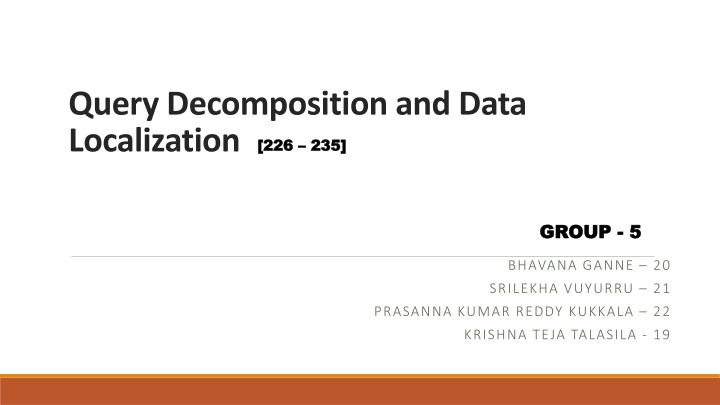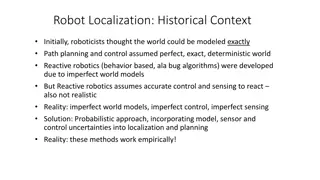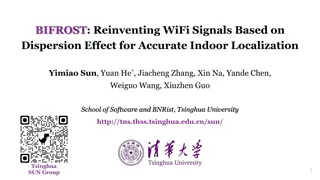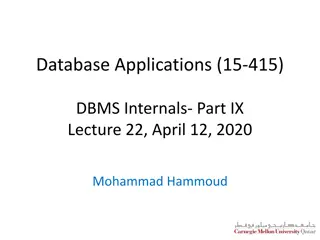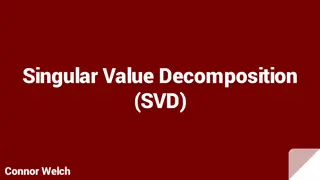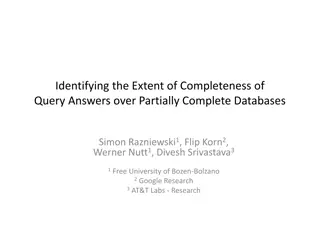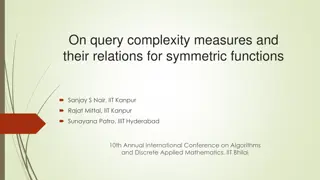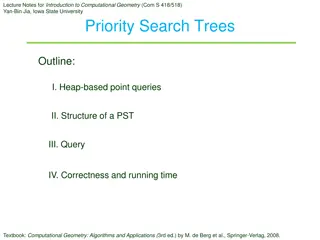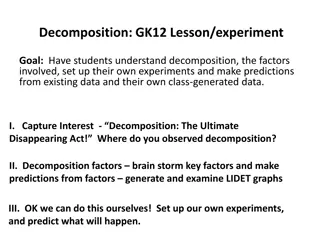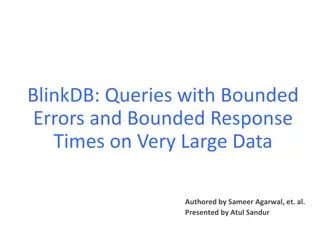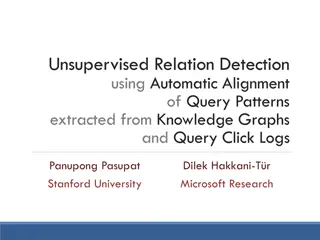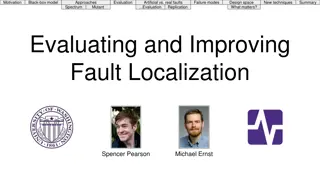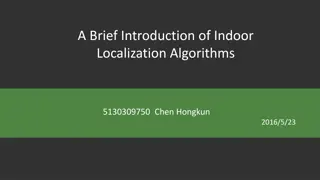Query Decomposition and Data Localization
This content discusses the process of query decomposition and data localization in databases. It covers topics such as analysis of query graphs, elimination of redundancy in queries, and rewriting queries for better efficiency. The examples provided illustrate the importance of semantic correctness in query structures and the steps involved in simplifying and optimizing queries.
Download Presentation

Please find below an Image/Link to download the presentation.
The content on the website is provided AS IS for your information and personal use only. It may not be sold, licensed, or shared on other websites without obtaining consent from the author.If you encounter any issues during the download, it is possible that the publisher has removed the file from their server.
You are allowed to download the files provided on this website for personal or commercial use, subject to the condition that they are used lawfully. All files are the property of their respective owners.
The content on the website is provided AS IS for your information and personal use only. It may not be sold, licensed, or shared on other websites without obtaining consent from the author.
E N D
Presentation Transcript
Query Decomposition and Data Localization [226 [226 235] 235] GROUP GROUP - - 5 5 BHAVANA GANNE 20 SRILEKHA VUYURRU 21 PRASANNA KUMAR REDDY KUKKALA 22 KRISHNA TEJA TALASILA - 19
Agenda Query Decomposition Data Localization
Query Decomposition Analysis Query/connection graph Nodes represent operand or result relation Edge represents a join if both connected nodes represent an operand relation, otherwise it is a projection Join graph a subgraph of the query graph that considers only the joins Since the query graph is connected, the query is semantically correct
Query Decomposition Analysis . . . Example: Consider the following query and its query graph: SELECT ENAME,RESPFROM FROM EMP, ASG, PROJ WHERE EMP.ENO = ASG.ENO AND PNAME = "CAD/CAM" ANDDUR 36 AND TITLE = "Programmer" Since the graph is not connected, the query is semantically incorrect. 3 possible solutions: Reject the query Assume an implicit Cartesian Product between ASG and PROJ Infer from the schema the missing join predicate ASG.PNO = PROJ.PNO
Query Decomposition Elimination of Redundancy Elimination of redundancy: Simplify the query by eliminate redundancies, e.g., redundant predicates Redundancies are often due to semantic integrity constraints expressed in the query language e.g., queries on views are expanded into queries on relations that satisfy certain integrity and security constraints Transformation rules are used, e.g., p p p p p p p true p p false p p false false p true true
Query Decomposition Elimination of Redundancy . . . Example: Consider the following query: SELECT Title FROM EMP WHEREEMP.ENAME = "J. Doe OR (NOT(EMP.TITLE = "Programmer") AND ( EMP.TITLE = "Elect. Eng. OR EMP.TITLE = "Programmer" ) AND NOT(EMP.TITLE = "Elect. Eng.")) Let p1 be ENAME = J. Doe , p2 be TITLE = Programmer and p3 be TITLE = Elect. Eng. Then the qualification can be written as p1 ( p2 (p2 p3) p3) and then be transformed into p1
Query Decomposition Rewriting Rewriting: Convert relational calculus query to relational algebra query and find an efficient expression. Example: Find the names of employees other than J. Doe who worked on the CAD/CAM project for either 1 or 2 years. SELECT ENAME FROM EMP, ASG, PROJ WHERE EMP.ENO = ASG.ENO AND ASG.PNO = PROJ.PNO AND ENAME =6 "J. Doe" AND PNAME = "CAD/CAM" AND (DUR = 12 OR DUR = 24)
Query Decomposition Rewriting . . . A query tree represents the RA-expression Relations are leaves (FROM clause) Result attributes are root (SELECT clause) Intermediate leaves should give a result from the leaves to the root By applying transformation rules, many different trees/expressions may be found that are equivalent to the original tree/expression, but might be more efficient . In the following we assume relations R(A1, . . . , An), S(B1, . . . , Bn), and T which is union-compatible to R.
Query Decomposition Rewriting . . . Commutativity of binary operations R S=S R R S=S R R S=S R Associativity of binary operations (R S) T=R (S T) (R S) T=R (S T) Idempotence of unary operations A( A(R)) = A(R) p1(A1)( p2(A2)(R)) = p1(A1) p2(A2)(R)
Query Decomposition Rewriting . . . Commuting selection with binary operations p(A)(R S) p(A)(R) S p(A1)(R p(A2,B2) S) p(A1)(R) p(A2,B2) S p(A)(R T ) p(A)(R) p(A)(T ) (A belongs to R and T ) Commuting projectionwith binary operations (assume C = A B , A A, B B) C (R S) A (R) B (S) C (R p(A ,B ) S) A (R) p(A ,B ) B (S) C (R S) C (R) C (S)
Query Decomposition Rewriting . . . Example: Two equivalent query trees for the previous example Recall the schemas: EMP(ENO, ENAME, TITLE) PROJ(PNO, PNAME, BUDGET) ASG(ENO, PNO, RESP, DUR)
Query Decomposition Rewriting . . . Example (contd.): Another equivalent query tree, which allows a more efficient query evaluation, since the most selective operations are applied first.
Data Localization Data localization Input: Algebraic query on global conceptual schema Purpose: Apply data distribution information to the algebra operations and determine which fragments are involved Substitute global query with queries on fragments Optimize the global query
Data Localization . . . Example: Assume EMP is horizontally fragmented into EMP1, EMP2, EMP3 as follows: EM P 1 = EN O E3 (EM P ) EM P 2 = E3 <EN O E6 (EM P ) EM P 3 = EN O> E6 (EM P ) ASG fragmented into ASG1 and ASG2 as follows: ASG1 = EN O E3 (ASG) ASG2 = EN O> E3 (ASG)
Data Localization . . . Simple approach: Replace in all queries EMP by (EMP1 EMP2 EMP3) ASG by (ASG1 ASG2) Result is also called generic query In general, the generic query is inefficient since important restructurings and simplifications can be done. Parallelism in the evaluation is often possible Depending on the horizontal fragmentation, the fragments can be joined in parallelfollowed by the union of the intermediate results.
Data Localizations Issues Various more advanced reduction techniques are possible to generate simpler and optimized queries. Reduction of horizontal fragmentation (HF) Reduction with selection Reduction with join Reduction of vertical fragmentation (VF) Find empty relations
Data Localizations Issues Reduction of HF Reduction with selection for HF Consider relation R with horizontal fragmentation F = {R1, R2, . . . , Rk }, where Ri = pi (R) Rule1: Selections on fragments, pj (Ri), that have a qualification contradicting the qualification of the fragmentation generate empty relation s, i.e., pj (Ri) = x R(pi(x) pj (x) = false) Can be applied if fragmentation predicate is inconsistent with the query selection predicate.
Data Localizations Issues Reduction for HF . . . Example: Consider the query: SELECT * FROM EMP WHERE ENO= E5 After commuting the selection with the union operation, it is easy to detect that the selection predicate contradicts the predicates of EMP1 and EMP3.
Data Localizations Issues Reduction for HF . . . Reduction with join for HF Joins on horizontally fragmented relations can be simplified when the joined relations are fragmented according to the join attributes. Distribute join over union (R1 R2) S (R1 S) (R2 S) Rule 2 : Useless joins of fragments, Ri = pi (R) and Rj = pj (R), can be determined when the qualifications of the joined fragments a re contradicting, i.e., Ri Rj = x Ri, y Rj (pi(x) pj (y) = false)
Data Localizations Issues Reduction for HF . . . Example: Consider the following query and fragmentation: Query: SELECT * FROM EMP, ASG WHERE EMP.ENO=ASG.ENO Horizontal fragmentation: EM P 1 = EN O E3 (EM P ) EM P 2 = E3 <EN O E6 (EM P ) EM P 3 = EN O> E6 (EM P ) Generic query The query reduced by distributing joins over unions and applying rule 2 can be implemented as a union of three partial joins that can be done in parallel.
Data Localizations Issues Reduction for HF . . . Reduction with join for derived HF The horizontal fragmentation of one relation is derived from the horizontalfragmentation of another relation by using semi joins. If the fragmentation is not on the same predicate as the join (as in the previous example), derived horizontal fragmentation can be applied in order to make efficient join processing possible. Example: Assume the following query and fragmentation of the EMP relation: Query: SELECT * FROM EMP, ASG WHERE EMP.ENO=ASG.ENO Fragmentation (not on the join attribute): EMP1 = TITLE= Prgrammer (EMP) EMP2 = TITLE=6 Prgrammer (EMP) To achieve efficient joins ASG can be fragmented as follows: ASG1= ASG <EN O EMP1 ASG2= ASG <EN O EMP2 The fragmentation of ASG is derived from the fragmentation of EMP Queries on derived fragments can be reduced, e.g.,ASG1 EM P2=
Data Localizations Issues Reduction for VF Reduction for Vertical Fragmentation Recall, VF distributes a relation based on projection, and the reconstruction operatoris the join. Similar to HF, it is possible to identify useless intermediate relations, i.e., fragments that do not contribute to the result. Assume a relationR(A)withA={A1, . . . , An}, which is vertically fragmented asRi= A i (R), where A i A. Rule 3 : D,K(Ri)is useless if the set of projection attributesDis not inA iandKis the key attribute. Note that the result is not empty, but it is useless, as it contains only the key attribute.
Data Localizations Issues Reduction for VF . . . Example: Consider the following query and vertical fragmentation: Query: SELECT ENAME FROM EMP Fragmentation: EM P 1 = EN O,EN AM E (EM P ) EM P 2 = EN O,T I T LE (EM P ) Generic query Reduced query By commuting the projection with the join (i.e., projecting on ENO, ENAME), we can see that the pro-jection on EMP2 is useless because ENAME is not in EMP2.
Conclusion Query decomposition and data localization maps calculus query into algebra operations and applies data distribution information to the algebra operations. Query decomposition consists of normalization, analysis, elimination of redundancy, and rewriting. Data localization reduces horizontal fragmentation with join and selection, and vertical fragmentation with joins, and aims to find empty relations.
